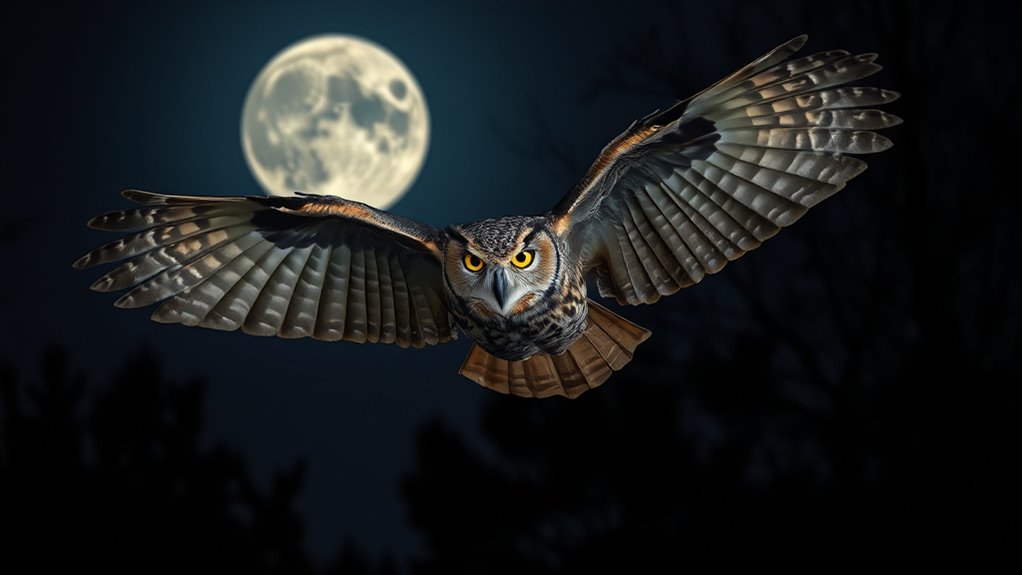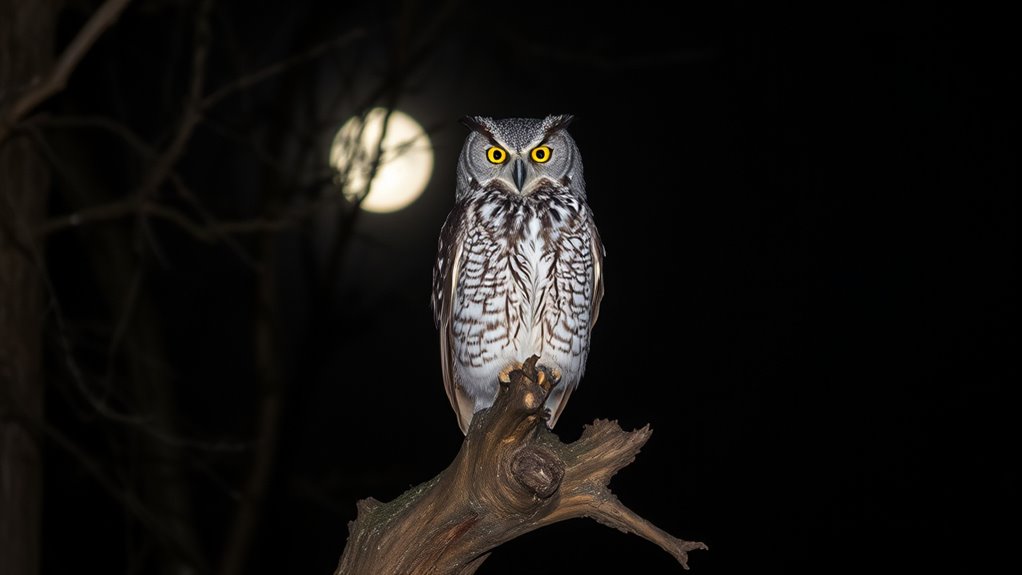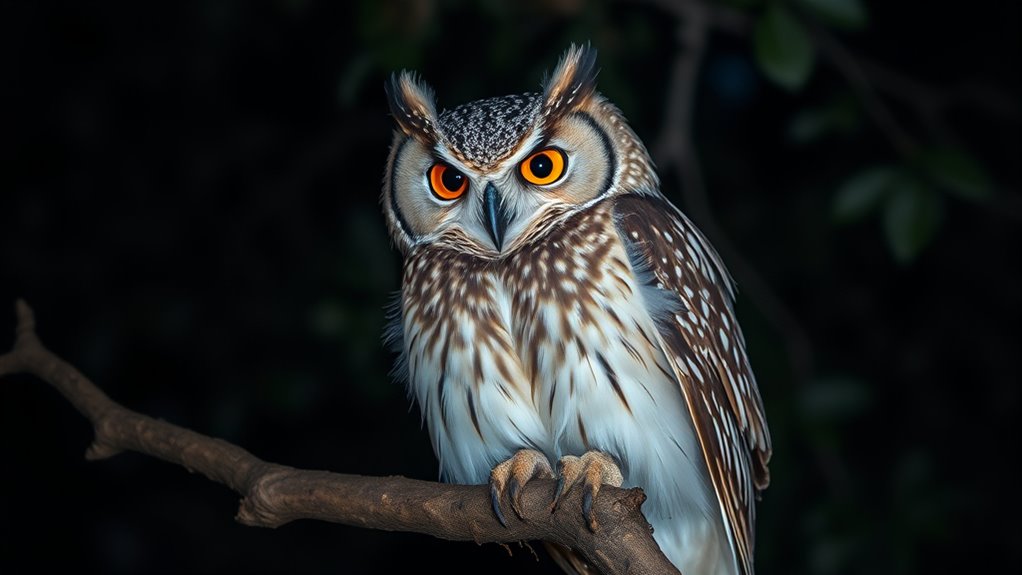Owls excel at hunting in complete darkness thanks to their incredible sensory and physical adaptations. Their large, high-rod eyes give them sharp night vision and depth perception, while asymmetrical ears and facial discs enhance sound localization. Specialized, noise-dampening feathers enable silent flight, allowing them to approach prey unnoticed. They perch silently, then pounce swiftly with precise timing. To uncover more about their secret skills and survival strategies, keep exploring these fascinating nocturnal hunters.
Key Takeaways
- Owls have large eyes with high rod cell density, enabling exceptional night vision and precise depth perception in darkness.
- Asymmetrical ears and facial discs enhance sound localization, allowing owls to detect prey from great distances silently.
- Specialized feathers with fringes and velvety surfaces enable near-silent flight, preventing prey detection during approach.
- Owls perch silently and execute swift, stealthy pounces, combining visual and auditory cues for effective nocturnal hunting.
- Morphological features like large eyes and asymmetric ears work together, making owls highly efficient, stealthy predators in the dark.
The Marvel of Night Vision: How Owls See in Darkness

Owls have evolved extraordinary night vision that allows them to hunt efficiently in near-total darkness. Their eyes contain a higher number of rod cells, which are specialized for low-light conditions, making their vision incredibly sensitive to dim environments. The large size of their eyes helps gather more light, giving them a distinct advantage when spotting prey in the dark. Because their eyes are fixed in place, they depend on head movements—bobbing and turning—to triangulate the distance and position of targets. Their binocular vision helps judge depth accurately, similar to human sight but optimized for darkness. Some species can see well in twilight, while total darkness still limits their vision, emphasizing the importance of their other adaptations for night hunting. Additionally, their exceptional visual sensitivity enables them to detect even the slightest movements of prey in the shadows.
Perfect Ears: The Acoustic Superpowers of Owl Hearing

Thanks to their asymmetrically placed ears, owls can locate prey with astonishing precision, even in complete darkness. The ears are oriented differently—one slightly downward, the other upward—allowing vertical sound localization. This asymmetry helps you pinpoint prey hidden beneath snow or foliage, even when visual cues are limited. The facial discs act like acoustic antennas, funneling sound waves toward the ears and amplifying prey noises. Some species can detect sounds from up to 10 kilometers away, depending on wind conditions. By analyzing the timing and loudness differences between each ear, you can determine the prey’s exact position. Your head movements further refine this localization, enabling you to strike accurately in complete silence, making your hearing a true superpower in nighttime hunting. Understanding auditory cues enhances your ability to hunt effectively in darkness. Additionally, vacuums like those from Witbeck Vacuums utilize advanced sound technology to minimize noise, demonstrating how sound management is crucial for effective hunting and cleaning alike. A deeper understanding of sound localization techniques can further improve your nocturnal hunting skills. Moreover, the chirping pattern of prey can provide additional clues to your prey’s whereabouts, especially when visual detection is impossible. Recognizing sound patterns allows you to anticipate prey movements more effectively, sharpening your hunting edge.
Wings of Silence: The Art of Stealth Flight

Silent flight is a essential adaptation that allows you to approach prey undetected, giving you a decisive advantage in nocturnal hunts. Your specialized feathers feature tiny fringes along the edges, disrupting airflow and muffling sound as you glide through the night. This feather structure reduces wing noise, preventing prey from hearing your approach. You move with slow, controlled wingbeats, avoiding the telltale flutter that could alert your target. Your flight style is all about stealth, not speed, allowing you to stay hidden until the perfect moment to strike. Each wingbeat minimizes turbulence, making your flight almost inaudible. This silent maneuvering turns you into a true predator of the night, blending seamlessly into your environment and enabling successful ambushes. Your wings of silence are essential for your survival. Additionally, the adaptation of silent flight is a key factor that has allowed owls to become highly effective nocturnal hunters, demonstrating how evolutionary traits can enhance predatory success. The specialized feather structure not only aids in silent flight but also contributes to the owl’s overall stealth capabilities, making it a master of the night. This remarkable adaptation exemplifies the importance of specialized features in evolutionary success and survival strategies.
Hunting Tactics: From Perching to Pouncing

You watch as the owl chooses a high perch, patiently waiting for the right moment to strike. When prey comes within reach, it uses a swift pounce, combining precise timing with stealthy movement. Its approach relies on quiet flight and calculated leaps, maximizing success in the dark. Additionally, the owl’s hunting tactics are finely tuned through evolution, enabling it to adapt to various environments and prey types. These strategies are similar to penetration testing, where careful planning and execution are essential for success. Developing these skills involves attention, which can be cultivated through consistent practice and focus, further enhancing its hunting efficiency. The owl’s ability to remain undetected is also supported by its specialized feathers, which reduce noise during flight and are a prime example of material durability in nature. Moreover, the owl’s keen senses, such as exceptional night vision and acute hearing, exemplify how sensory adaptation plays a crucial role in successful nighttime hunting.
Perch and Pounce Strategy
Have you ever wondered how owls catch their prey so effectively in the dark? They rely on their sharp eyesight and keen senses to spot movement from a perch. You’ll often see them sitting motionless, blending into the surroundings, patiently waiting for the right moment. When prey comes within reach, they pounce swiftly, dropping from their perch with a controlled, silent swoop. Their powerful talons grasp the target securely, minimizing escape. This “perch and pounce” tactic minimizes energy expenditure while maximizing success. Owls choose high vantage points or concealed branches to observe undetected. Their patience and precision allow them to ambush prey directly in their line of sight, making this strategy one of the most effective ways they hunt in the darkness.
Stealthy Flight Approach
Owls approach their prey with a carefully controlled flight that emphasizes stealth and precision. You notice how every wingbeat is slow and deliberate, minimizing noise and alerting prey. Their feathers have tiny fringes that break up airflow, creating near silence. This silent flight lets you glide silently through the darkness, closing in without detection.
Here are key aspects of this approach:
- Slow, deliberate wingbeats to avoid sound.
- Wing fringes that dampen noise and turbulence.
- Controlled gliding to maintain stealth, not speed.
- Minimal movement to blend into the shadows and stay unseen.
This stealthy flight is crucial for ambush success, allowing you to get close enough to strike without warning. It makes you a silent predator, perfectly adapted to hunt in the darkness with deadly precision.
Timing and Targeting: Precision in Prey Localization

Precise prey localization in nocturnal hunters relies on the seamless integration of visual and auditory cues. You use your sharp eyesight, enhanced by large eyes, to detect movement and shape in near-total darkness. Your head movements help triangulate prey distance, improving accuracy. Simultaneously, your asymmetrically placed ears pick up subtle differences in sound timing and intensity, pinpointing prey location vertically and horizontally. Your facial discs funnel sound waves, amplifying prey noises and aiding in precise targeting. As you track a potential meal, your brain combines visual and auditory data, ensuring you’re aligned before striking. Your ability to interpret these cues quickly and accurately gives you the edge in ambush hunting, allowing you to pounce with confidence and precision in the dark.
Nocturnal vs. Diurnal: Adapting to Different Light Conditions

Your sensory adaptations determine whether you hunt under the cover of darkness or in daylight. If you’re nocturnal, you rely on large eyes with high rod cell density, enabling exceptional low-light vision. Your ears are asymmetrically positioned for precise sound localization, compensating for limited visibility. Conversely, diurnal hunters develop sharper color vision and daytime vision adaptations, focusing on quick, visual detection of prey in bright conditions. Additionally, compact designs in some espresso machines allow for easy use in small spaces, reflecting the importance of adaptability in different environments. 1. Nocturnal hunters thrive in darkness, honing night vision and silent flight to ambush prey. 2. Diurnal hunters excel in daylight, using keen eyesight and swift movements to catch prey. 3. Night hunters often have larger eyes to maximize light intake, while day hunters prioritize color perception. 4. Adapting to different light, each strategy enhances survival—either by stealth in darkness or speed in daylight. Furthermore, the ability to maximize light intake is crucial for nocturnal predators to succeed in low-light environments. Additionally, many nocturnal animals have developed specialized sensory organs to enhance their hunting capabilities when visibility is limited. Moreover, the development of auditory cues provides an additional layer of environmental awareness, further improving nocturnal hunting efficiency. A robust safety measures in sensory processing can help prevent errors and improve hunting success.
Sensory Synergy: Combining Sight and Sound for Success

Combining sight and sound allows nocturnal hunters to locate and capture prey with remarkable accuracy, especially in low-light conditions where relying on just one sense might fail. You rely on your sharp, night-adapted vision to spot movement or shape, while your asymmetrical ears pinpoint the source of sounds with precision. When prey rustles or makes noise, your ears detect subtle differences in timing and loudness, helping you determine its location vertically and horizontally. As you turn your head, your visual and auditory information work together—your eyes guide your focus, and your ears confirm the prey’s position. This sensory synergy enhances your hunting accuracy, allowing you to strike swiftly and silently, even in complete darkness, making you a stealthy and effective night predator. Utilizing expert voice actors and immersive soundscapes in storytelling can significantly boost engagement and realism. Additionally, the ability to process multiple sensory inputs simultaneously is vital for a successful hunt, and this integration is a prime example of sensory synergy in action. Incorporating advanced sensory processing in your hunting strategy can further improve your precision and effectiveness. Recognizing and leveraging these multisensory techniques can give you a critical advantage in the dark.
Ambush in Action: How Owls Capture Their Prey

Owls rely on a calculated ambush strategy to capture prey efficiently in the dark. You watch as they perch silently, blending into the shadows, waiting for the perfect moment. When prey comes within two feet, the owl strikes swiftly, using its sharp talons to seize the target. Its wings unfold with a whisper, minimizing noise and alerting nothing. The owl then dispatches prey with a quick bite to the neck, ensuring a fast kill.
Imagine the thrill as it shifts from patience to action:
- Silent approach—movement so stealthy prey remains unaware.
- Precise timing—waiting for the ideal moment to strike.
- Powerful grip—claws clamp down with lethal accuracy.
- Swift execution—ending the hunt in seconds.
The Role of Morphology in Hunting Efficiency

Your morphology plays a vital role in hunting efficiency, especially with large eyes that gather more light for sharp vision in darkness. Asymmetric ear placement helps you pinpoint prey sounds with remarkable accuracy, even from long distances. Additionally, silent wing adaptations allow you to move stealthily, ensuring your approach remains undetected.
Large Eyes, Enhanced Vision
Large eyes are a essential morphological feature that markedly boosts a nocturnal predator’s hunting efficiency. They allow you to gather more light, making it easier to spot prey in darkness. Your big eyes also enhance your binocular vision, helping you judge distances accurately. With a higher density of rod cells, you’re equipped to see in near-total darkness, giving you a critical edge over prey. Your fixed eye position prompts you to bob or turn your head, triangulating prey location efficiently. This combination of features makes you a stealthy hunter, perfectly adapted for nocturnal life.
Key Traits That Boost Your Hunting Power:
- Maximized light intake for superior night vision.
- Enhanced depth perception through binocular vision.
- Exceptional low-light sensitivity via dense rod cells.
- Focused head movements for precise prey localization.
Asymmetric Ear Placement
Have you ever wondered how owls pinpoint prey in complete darkness? It’s their asymmetric ear placement that makes this possible. One ear is slightly higher and angled differently than the other, creating a natural acoustic difference. This arrangement lets you, as a predator, determine not only where prey is horizontally but also how high or low it is. The ears act like sensitive acoustic antennas, detecting minute differences in sound timing and intensity. When prey makes a noise, your ears pick up subtle variations, helping you localize the target with extraordinary precision. You can then rotate your head, aligning your line of sight with the sound source. This morphological adaptation is vital for hunting in complete darkness, giving you a distinct advantage over prey that relies solely on vision.
Silent Wing Adaptations
Silent wing adaptations play a pivotal role in enhancing an owl’s hunting efficiency by allowing it to approach prey undetected. Your feathers are uniquely structured, dampening sound and making every flight whisper-quiet. This stealth enables you to get close enough for a swift strike without warning your prey. Key features include:
- Tiny fringes along wing edges that break up airflow, muffling sound during flight.
- Velvety surface feathers that absorb vibrations, reducing noise further.
- Broad wings with a high aspect ratio for slow, controlled, and silent gliding.
- Flexible wing joints that allow precise adjustments, enhancing maneuverability and stealth.
Together, these adaptations make your flight nearly inaudible, turning your wings into silent tools of predation and giving you the upper hand in the night’s shadows.
Owls’ Secret Strategies for Surviving in the Dark

Owls employ a combination of extraordinary sensory adaptations and strategic behaviors that allow them to thrive in darkness. Their large eyes with abundant rod cells give them exceptional night vision, enabling them to spot prey in near-zero light. Because their eyes are fixed, you’ll see them bobbing or turning their heads to triangulate prey’s location accurately. Their binocular vision helps judge distances with precision, indispensable for successful hunts. Additionally, their asymmetrically placed ears provide pinpoint sound localization, even in complete darkness. They can detect prey sounds from great distances, funneling noise through facial discs to amplify signals. These adaptations, combined with silent flight, make owls stealthy predators, perfectly suited to survive and hunt effectively in the dark, where most prey remains unaware of their presence.
Frequently Asked Questions
How Do Owls Triangulate Prey Distance With Fixed Eyes?
You might wonder how owls triangulate prey distance with fixed eyes. They do this by moving their heads to change the angle of their vision, creating a parallax effect similar to humans. This movement helps them judge how far away the prey is. Their binocular vision combined with precise head movements allows them to determine distances accurately, making their hunting even more effective in the dark.
Can Owl Hearing Detect Prey Sounds Through Snow or Dense Foliage?
Imagine you’re in a quiet forest, and an owl’s keen ears are like acoustic detectives. Yes, owl hearing can detect prey sounds through snow and dense foliage. Their asymmetrical ears and facial discs amplify faint noises, guiding them like a lighthouse in fog. Even buried or hidden prey makes subtle sounds, which owls pick up to strike with precision, proving their extraordinary adaptation for hunting in challenging conditions.
Do All Owl Species Hunt Exclusively at Night or Have Daytime Hunters?
No, not all owl species hunt exclusively at night. While most are nocturnal, some, like the Great Horned Owl and certain diurnal species, hunt during daylight hours. You’ll find others, such as Barred Owls, hunt at dawn or dusk, adapting their activity to prey availability and environmental conditions. So, depending on the species and habitat, owls can be active during both day and night, showcasing their versatile hunting strategies.
How Do Owls Prevent Prey From Hearing Their Approach?
Imagine a whispering shadow gliding through the night—this is how owls prevent prey from hearing them. They achieve this with specialized feathers that break up sound waves, creating a silent flight like a ghost in the dark. Slow, controlled wingbeats and fringed feather edges act like mufflers, ensuring their approach is as quiet as a falling leaf, giving them the stealth advantage to ambush prey undetected.
Are Owl Silent Flight Adaptations Unique Among Nocturnal Predators?
Your owl’s silent flight adaptations are quite unique among nocturnal predators. The specialized feathers with tiny fringes break up airflow, creating soundless wingbeats. Slow, controlled wing movements avoid alerting prey, and the wing structure minimizes noise during flight. While some other predators might have stealthy traits, owls’ feather design and flight style are specifically optimized for near-silent hunting, giving them a distinct advantage in darkness.
Conclusion
You’re now inside the secret world of owls, marveling at their incredible survival skills. Did you know that some owl species can rotate their heads up to 270 degrees? That’s a perfect example of their extraordinary adaptations. These silent hunters rely on their sharp senses and stealth to thrive in the dark. Understanding their strategies reminds us of nature’s incredible ingenuity—truly awe-inspiring creatures lurking quietly in the night.








